Organic Matter Burial in Deep-Sea Fans: A Depositional Process-Based Perspective
Abstract
:1. Introduction
2. Organic Matter Deposition and Burial in Submarine Fans
2.1. Suspension Settling
2.2. Turbidity Currents
2.3. Hybrid Sediment Gravity Flows
3. Discussion
4. Conclusions
Author Contributions
Funding
Institutional Review Board Statement
Informed Consent Statement
Data Availability Statement
Acknowledgments
Conflicts of Interest
References
- Saller, A.; Lin, R.; Dunham, J. Leaves in turbidite sands: The main source of oil and gas in the deep-water Kutei Basin, Indonesia. AAPG Bull. 2006, 90, 1585–1608. [Google Scholar] [CrossRef]
- Galy, V.; France-Lanord, C.; Beyssac, O.; Faure, P.; Kudrass, H.; Palhol, F. Efficient organic carbon burial in the Bengal fan sustained by the Himalayan erosional system. Nature 2007, 450, 407–411. [Google Scholar] [CrossRef] [PubMed]
- Baudin, F.; Disnar, J.R.; Martinez, P.; Dennielou, B. Distribution of the organic matter in the channel-levees systems of the Congo mud-rich deep-sea fan (West Africa). Implication for deep offshore petroleum source rocks and global carbon cycle. Mar. Pet. Geol. 2010, 27, 995–1010. [Google Scholar] [CrossRef] [Green Version]
- Baudin, F.; Stetten, E.; Schnyder, J.; Charlier, K.; Martinez, P.; Dennielou, B.; Droz, L. Origin and distribution of the organic matter in the distal lobe of the Congo deep-sea fan-a rock-Eval survey. Deep Sea Res. Part II 2017, 142, 75–90. [Google Scholar] [CrossRef] [Green Version]
- Biscara, L.; Mulder, T.; Martinez, P.; Baudin, F.; Etcheber, H.; Jouanneau, J.M.; Garlan, T. Transport of terrestrial organic matter in the Ogooue deep sea turbidite system (Gabon). Mar. Pet. Geol. 2011, 28, 1061–1072. [Google Scholar] [CrossRef]
- Talling, P.J. Hybrid submarine flows comprising turbidity current and cohesive debris flow: Deposits, theoretical and experimental analyses, and generalized models. Geosph. 2013, 9, 460–488. [Google Scholar] [CrossRef] [Green Version]
- Schnyder, J.; Stetten, E.; Baudin, F.; Pruski, A.M.; Martinez, P. Palynofacies reveal fresh terrestrial organic matter inputs in the terminal lobes of the Congo deep-sea fan. Deep Sea Res. Part II 2017, 142, 91–108. [Google Scholar] [CrossRef]
- Kvale, E.P.; Bowie, C.M.; Flenthrope, C.; Mace, C.; Parrish, J.M.; Price, B.; Anderson, S.; DiMichele, W.A. Facies variability within a mixed carbonate-siliciclastic seafloor fan (upper Wolfcamp Fm., Permian, Delaware Basin, New Mexico). AAPG Bull. 2019, 104, 525–563. [Google Scholar] [CrossRef]
- Rabouille, C.; Dennielou, B.; Baudin, F.; Raimonet, M.; Droz, L.; Khripounoff, A.; Martinez, P.; Mejanelle, L.; Michalopoulos, P.; Pastor, L.; et al. Carbon and silica megasink in deep-sea sediments of the Congo terminal lobes. Quat. Sci. Rev. 2019, 222, 105854. [Google Scholar] [CrossRef]
- Hage, S.; Galy, V.; Cartigny, M.; Acikalin, S.; Clare, M.A.; Grocke, D.; Hilton, R.; Hunt, J.; Lintern, D.; Mcghee, C.; et al. Efficient preservation of young terrestrial organic carbon in sandy turbidity-current deposits. Geology 2020, 48, 882–887. [Google Scholar] [CrossRef]
- Hussain, A.; Haughton, P.; Shannon, P.; Morris, E.; Pierce, C.; Omma, J. Mud-forced turbulence dampening facilitates rapid burial and enhanced preservation of terrestrial organic matter in deep-sea environments. Mar. Pet. Geol. 2021, 130, 105101. [Google Scholar] [CrossRef]
- McArthur, A.; Kneller, B.; Wakefield, M.; Souza, P.; Kuchle, J. Palynofacie classification of the depositional elements of confined turbidite systems: Examples from the Gres d’Annot, SE France. Mar. Pet. Geol. 2016, 77, 1254–1273. [Google Scholar] [CrossRef] [Green Version]
- McArthur, A.; Gamberi, F.; Kneller, B.; Wakefield, M.; Souza, P.; Kuchle, J. Palynofacies classification of submarine fan depositional environments: Outcrop examples from the Marnoso-Arenacea Formation. Italy. Mar. Pet. Geol. 2017, 88, 181–199. [Google Scholar] [CrossRef]
- Berner, R. Burial of organic carbon and pyrite sulfur in the modern ocean: Its geochemical and environmental significance. Am. J. Sci. 1982, 282, 451–473. [Google Scholar] [CrossRef]
- Berner, R.A. Atmospheric carbon dioxide levels over Phanerozoic time. Science 1990, 249, 1382–1386. [Google Scholar] [CrossRef] [PubMed]
- France-Lanord, C.; Derry, L. Organic carbon burial forcing of the carbon cycle from Himalayan erosion. Nature 1997, 390, 65–67. [Google Scholar] [CrossRef]
- Hayes, J.M.; Strauss, H.; Kaufman, A. The abundance of 13C in marine organic matter and isotopic fractionation in the global biogeochemical cycle of carbon during the past 800 Ma. Chem. Geol. 1999, 161, 103–125. [Google Scholar] [CrossRef]
- Hayes, J.; Waldbauer, J. The carbon cycle and associated redox processes through time: Philosophical Transections B. R. Soc. Lond. Biol. Sci. 2006, 361, 931–950. [Google Scholar] [CrossRef] [Green Version]
- Abbate, E.; Bortolotti, V.; Passerini, P. Olistostromes and olistoliths. Sediment. Geol. 1970, 4, 521–557. [Google Scholar] [CrossRef]
- Carter, R. A discussion and classification of subaqueous mass-transport with particular application to gravity flow, slurry flow and fluxo-turbidites. Earth Sci. Rev. 1975, 11, 145–177. [Google Scholar] [CrossRef]
- Middleton, G.; Hampton, M. Subaqueous sediment transport and deposition by sediment gravity waves. In Marine Sediment Transport and Environmental Management; Stanley, D.J., Swift, D.J., Eds.; Wiley: New York, NY, USA, 1976; pp. 197–218. [Google Scholar]
- Marr, J.G.; Shanmugam, G.; Parker, G. Experiments on subaqueous sandy gravity flows: The role of clay and water content in flow dynamics and depositional structures. Bull. Geol. Soc. Am. 2001, 113, 1377–1386. [Google Scholar] [CrossRef]
- Bouma, A.H. Turbidites. Dev. Sedimentol. 1962, 3, 247–256. [Google Scholar] [CrossRef]
- Stow, D.A.; Shanmugam, G. Sequence of structures in fine-grained turbidites: Comparison of recent deep-sea and ancient flysch sediments. Sediment. Geol. 1980, 25, 23–42. [Google Scholar] [CrossRef]
- Lowe, D. Sediment gravity flows: II Depositional models with special reference to the deposits of high-density turbidity currents. J. Sediment. Res. 1982, 52, 279–297. [Google Scholar]
- Kneller, B.; Buckee, C. The structure and fluid mechanics of turbidity currents: A review of some recent studies and their geological implications. Sedimentology 2000, 47, 62–94. [Google Scholar] [CrossRef]
- Mulder, T.; Alexander, J. The physical character of subaqueous sedimentary density flows and their deposits. Sedimentology 2001, 48, 269–299. [Google Scholar] [CrossRef]
- Pickering, K.; Hiscott, R.; Hein, F. Deep Marine Environments: Clastic Sedimentation and Tectonics; Unwin Hyman Ltd.: London, UK, 1989; p. 416. [Google Scholar]
- Nemec, W. Aspects of sediment movement on steep delta slopes. In Coarse Grained Deltas; Colella, A., Prior, D., Eds.; Special Publication of the International Association of Sedimentologists; International Association of Sedimentologists: Oxford, UK, 1990. [Google Scholar]
- Stow, D.V.; Johansson, M. Deep-water massive sands: Nature, origin and hydrocarbon implications. Mar. Pet. Geol. 2000, 17, 145–174. [Google Scholar] [CrossRef]
- Haughton, P.; Barker, S.; McCaffrey, W. ‘Linked’ debrites in sand-rich turbidite systems–origin and significance. Sedimentology 2003, 50, 459–482. [Google Scholar] [CrossRef]
- Haughton, P.; Davis, C.; McCaffrey, W.; Barker, S. Hybrid sediment gravity flow deposits—Classification, origin and significance. Mar. Pet. Geol. 2009, 26, 1900–1918. [Google Scholar] [CrossRef]
- Talling, P.; Amy, L.; Wynn, R.; Peakall, J.; Robinson, M. Beds comprising debrite sandwiched within co-genetic turbidite: Origin and widespread occurrence in distal depositional environments. Sedimentology 2004, 51, 163–194. [Google Scholar] [CrossRef]
- Wood, A.; Smith, A. The sedimentation and sedimentary history of the Aberystwyth Grits (Upper Llandoverian). J. Geol. Soc. Lond. 1958, 114, 163–195. [Google Scholar] [CrossRef]
- Lowe, D.; Guy, M. Slurry-flow deposits in the Britannia Formation (Lower Cretaceous), North Sea: A new perspective on the turbidity current and debris flow problem. Sedimentology 2000, 47, 31–70. [Google Scholar] [CrossRef]
- Blackbourn, G.; Thomason, M. Britannia Field, UK North Sea: Petrographic constraints on Lower Cretaceous provenance, facies, and the origin of slurry-flow deposits. Pet. Geosci. 2000, 6, 329–343. [Google Scholar] [CrossRef]
- Barker, S.; Haughton, P.; McCaffrey, W.; Archer, S.; Hakes, B. Development of rheological heterogeneity in clay-rich high-density turbidity currents: Aptian Britannia Sandstone Member, UK continental shelf. J. Sediment. Res. 2008, 78, 45–68. [Google Scholar] [CrossRef]
- Sylvester, Z.; Lowe, D. Textural trends in turbidites and slurry beds from the Oligocene flysch of the East Carpathians, Romania. Sedimentology 2004, 51, 945–972. [Google Scholar] [CrossRef]
- Talling, P.; Wynn, R.; Masson, D.; Frenz, M.; Cronin, B.; Schiebel, R.; Akhmetzhanov, A.; Dallmeier, T.; Benetti, S.; Weaver, P. Onset of submarine debris flow deposition far from original giant landslide. Nature 2007, 450, 541–544. [Google Scholar] [CrossRef]
- Talling, P.; Masson, D.; Sumner, E.; Malgesini, G. Subaqueous sediment density flows: Depositional processes and deposit types. Sedimentology 2012, 59, 1937–2003. [Google Scholar] [CrossRef]
- Ito, M. Downfan transformation from turbidity currents to debris flows at a channel-to-lobe transitional zone: The lower Pleistocene Otadai Formation, Boso Peninsula, Japan. J. Sediment. Res. 2008, 78, 668–682. [Google Scholar] [CrossRef]
- Hodgson, D. Distribution and origin of hybrid beds in sand-rich submarine fans of the Tanqua depocentre, Karoo Basin, South Africa. Mar. Pet. Geol. 2009, 26, 1940–1956. [Google Scholar] [CrossRef]
- Kane, I.; Pontén, A. Submarine transitional flow deposits in the Paleogene Gulf of Mexico. Geology 2012, 40, 1119–1122. [Google Scholar] [CrossRef]
- Patacci, M.; Haughton, P.; McCaffrey, W. Rheological complexity in sediment gravity flows forced to decelerate against a confining slope, Braux, SE France. J. Sediment. Res. 2014, 84, 270–277. [Google Scholar] [CrossRef]
- Fonnesu, M.; Haughton, P.; Felletti, F.; McCaffrey, W. Short length-scale variability of hybrid event beds and its applied significance. Mar. Pet. Geol. 2015, 67, 583–603. [Google Scholar] [CrossRef] [Green Version]
- Fonnesu, M.; Patacci, M.; Haughton, P.; Felletti, F.; McCaffrey, W. Hybrid event beds generated by local substrate delamination on a confined-basin floor. J. Sediment. Res. 2016, 86, 929–943. [Google Scholar] [CrossRef]
- Fonnesu, M.; Felletti, F.; Haughton, P.; Patacci, M.; McCaffrey, W. Hybrid event bed character and distribution linked to turbidite sub-environments: The North Apennine Gottero Sandstone (north-west Italy). Sedimentology 2018, 65, 151–190. [Google Scholar] [CrossRef] [Green Version]
- Kane, I.; Pontén, A.; Vangdal, B.; Eggenhuisen, J.; Hodgson, D.; Spychala, Y. The stratigraphic record and processes of turbidity current transformation across deep-marine lobes. Sedimentology 2017, 64, 1236–1273. [Google Scholar] [CrossRef] [Green Version]
- Southern, S.; Kane, I.; Warchoł, M.; Porten, K.; McCaffrey, W. Hybrid event beds dominated by transitional-flow facies: Character, distribution and significance in the Maastrichtian Springar Formation, north-west Vøring Basin, Norwegian Sea. Sedimentology 2017, 64, 747–776. [Google Scholar] [CrossRef] [Green Version]
- Fildani, A.; Clark, J.; Covault, J.; Power, B.; Romans, B.; Aiello, I. Muddy sand and sandy mud on the distal Mississippi fan: Implications for lobe depositional processes. Geosphere 2018, 14, 1051–1066. [Google Scholar] [CrossRef] [Green Version]
- Pierce, C.; Haughton, P.; Shannon, P.; Pulham, A.; Barker, S.; Martinsen, O. Variable character and diverse origin of hybrid event beds in a sandy submarine fan system, Pennsylvanian Ross Sandstone Formation, western Ireland. Sedimentology 2018, 65, 952–992. [Google Scholar] [CrossRef]
- Angus, K.; Arnott, W.C.; Terlaky, V. Lateral and vertical juxtaposition of matrix-rich and matrix-poor lithologies caused by particle settling in mixed mud–sand deep-marine sediment suspensions. Sedimentology 2019, 66, 940–962. [Google Scholar] [CrossRef]
- Hussain, A.; Haughton, P.; Shannon, P.; Turner, J.; Pierce, C.; Obradors-Latre, A.; Barker, S.; Martinsen, O. High-resolution X-ray fluorescence profiling of hybrid event beds: Implications for sediment gravity flow behaviour and deposit structure. Sedimentology 2020, 67, 2850–2882. [Google Scholar] [CrossRef]
- Brooks, H.; Ito, M.; Zuchuat, V.; Peakall, J.; Hodgson, D. Channel-lobe transition zone development in tectonically active settings: Implications for hybrid bed development. Depos. Rec. 2022, 1–40. [Google Scholar] [CrossRef]
- Stow, D.; Smillie, Z. Distinguishing between Deep-Water Sediment Facies: Turbidites, Contourites and Hemipelagites. Geosciences 2020, 10, 68. [Google Scholar] [CrossRef] [Green Version]
- Wynn, R.; Masson, D.; Stow, D.; Weaver, P. The Northwest African slope apron: A modern analogue for deep water systems with complex seafloor topography. Mar. Pet. Geol. 2000, 17, 253–265. [Google Scholar] [CrossRef]
- Boulesteix, K.; Poyatos-More, M.; Flint, S.; Taylor, K.; Hodgson, D.; Hasiotis, S. Transport and deposition of mud in deep-water environments: Processes and stratigraphic implications. Sedimentology 2019, 66, 2894–2925. [Google Scholar] [CrossRef]
- Stow, D. Fine-grained sediments in deep water: An overview of processes and facies models. GeoMarine Lett. 1985, 5, 17–23. [Google Scholar] [CrossRef]
- Plint, G. Mud dispersal across a Cretaceous prodelta: Storm-generated, wave-enhanced sediment gravity flows inferred from mudstone microtexture and Microfacies. Sedimentology 2014, 61, 609–647. [Google Scholar] [CrossRef]
- Schieber, J.; Southard, J.; Thaisen, K. Accretion of mudstone beds from migrating floccule ripples. Science 2007, 318, 1760–1763. [Google Scholar] [CrossRef] [Green Version]
- Schieber, J.; Southard, J. Bedload transport of mud by floccule ripples-direct observation of ripple migration processes and their implications. Geology 2009, 37, 483–486. [Google Scholar] [CrossRef] [Green Version]
- Könitzer, S.; Davies, S.; Stephenson, H.; Leng, M. Depositional controls on mudstone lithofacies in a basinal setting–implications for the delivery of sedimentary organic matter. J. Sediment. Res. 2014, 84, 198–214. [Google Scholar] [CrossRef]
- Boulesteix, K.; Poyatos-Moré, M.; Flint, S.; Hodgson, D.; Taylor, K.; Brunt, R. Sedimentological and stratigraphic criteria to distinguish between basin-floor and slope mudstones: Implications for the delivery of mud to deep-water environments. Depos. Rec. 2022. [Google Scholar] [CrossRef]
- Hedges, J.; Keil, R. Sedimentary organic matter preservation: An assessment and speculative synthesis. Mar. Chem. 1995, 49, 81–115. [Google Scholar] [CrossRef]
- Blair, N.; Leithold, E.; Brackley, H.; Trustrum, N.; Page, M.; Childress, L. Terrestrial sources and export of particulate organic carbon in the Waipaoa sedimentary system: Problems, progress and processes. Mar. Geol. 2010, 270, 108–118. [Google Scholar] [CrossRef]
- Baudin, F.; Rabouille, C.; Dennielou, B. Routing of terrestrial organic matter from the Congo River to the ultimate sink in the abyss: A mass balance approach. Geol. Belg. 2020, 23, 41–52. [Google Scholar] [CrossRef]
- Stetten, E.; Baudin, F.; Reyss, J.; Martinez, P.; Charlier, K.; Schnyder, J.; Rabouille, C.; Dennielou, B.; Coston-Guarini, J.; Pruski, A. Organic matter characterization and distribution in sediments of the terminal lobes of the Congo deep-sea fan: Evidence for the direct influence of the Congo River. Mar. Geol. 2015, 369, 182–195. [Google Scholar] [CrossRef] [Green Version]
- Hemingway, J.; Rothman, D.; Grant, K.; Rosengard, S.; Eglinton, T.; Derry, L.; Galy, V. Mineral protection regulates long-term global preservation of natural organic carbon. Nature 2019, 570, 228–231. [Google Scholar] [CrossRef]
- Keil, R.G.; Tsamakis, E.; Wolf, N.; Hedges, J.; Goñi, M. Relationships between organic carbon preservation and mineral surface area in Amazon Fan sediments (Holes 920 932A and 942A). Proc. ODP Sci. Results 1997, 155, 531–538. [Google Scholar]
- Masiello, C.A. Quick burial at sea. Nature 2007, 450, 360–361. [Google Scholar] [CrossRef]
- Burdige, D. Burial of terrestrial organic matter in marine sediments: A reassessment. Glob. Biogeochem. Cycles 2005, 19, 1–7. [Google Scholar] [CrossRef]
- Stanley, D. Turbidity current transport of organic-rich sediments: Alpine and Mediterranean examples. Mar. Geol. 1986, 70, 85–101. [Google Scholar] [CrossRef]
- Pyles, D.; Straub, K.; Stammer, J. Spatial variations in the composition of turbidites due to hydrodynamic fractionation. Geophys. Res. Lett. 2013, 40, 3919–3923. [Google Scholar] [CrossRef]
- Ghadeer, S.; Macquaker, J. The role of event beds in the preservation of organic carbon in fine-grained sediments: Analyses of the sedimentological processes operating during deposition of the Whitby Mudstone Formation (Toarcian, Lower Jurassic) preserved in northeast England. Mar. Pet. Geol. 2012, 35, 309–320. [Google Scholar] [CrossRef]
- Nittrouer, C.; Sternberg, R. The formation of sedimentary strata in anallochthonous shelf. In Developments in Sedimentology; Elsevier: Amsterdam, The Netherlands, 1981; Volume 32, pp. 201–232. [Google Scholar]
- Bentley, S.; Nittrouer, C.; Sommerfield, C. Development of sedimentary strata in Eckernförde Bay, southwestern Baltic Sea. Geo-Mar. Lett. 1996, 16, 148–154. [Google Scholar] [CrossRef]
- Bentley, S.; Nittrouer, C. Physical and biological influences on the formation of sedimentary fabric in an oxygen-restricted depositional environment: Eckemforde Bay, Southwestern Baltic Sea. Palaios 1999, 14, 585–600. [Google Scholar] [CrossRef]
- Bohacs, K.; Norton, I.; Gilbert, D.; Neal, J.; Kennedy, M.; Borkowski, W.; Rottman, M.; Burke, T. The Accumulation of Organic-Matter-Rich Rocks within an Earth Systems Framework: The integrated roles of Plate Tectonics, Atmosphere, Ocean, and Biota through the Phanerozoic. Princ. Geol. Anal. 2020, 721–744. [Google Scholar] [CrossRef]
- Pedersen, T.; Calvert, S. Anoxia vs. productivity: What controls the formation of organic-carbon-rich sediments and sedimentary rocks? AAPG Bull. 1990, 74, 454–466. [Google Scholar]
- Pickering, K.; Pouderoux, H.; McNeill, L.; Backman, J.; Chemale, C.; Kutterolf, S.; Milliken, K.; Mukoyoshi, H.; Henstock, T.; Stevens, D.; et al. Sedimentology, stratigraphy and architecture of the Nicobar Fan (Bengal–Nicobar Fan System), Indian Ocean: Results from International Ocean Discovery Program Expedition 362. Sedimentology 2020, 67, 2248–2281. [Google Scholar] [CrossRef]
- Collinson, J.; Martinsen, O.; Bakken, B.; Kloster, A. Early fill of the Western Irish Namurian Basin: A complex relationship between turbidites and deltas. Basin Res. 1991, 3, 223–242. [Google Scholar] [CrossRef]
- Liang, C.; Jiang, Z.; Cao, Y.; Wu, M.; Guo, L.; Zhang, C. Deep-water depositional mechanisms and significance for unconventional hydrocarbon exploration: A case study from the lower Silurian Longmaxi shale in the southeastern Sichuan Basin. AAPG Bull. 2016, 100, 773–794. [Google Scholar] [CrossRef]
- Kuenen, P. Sole markings of graded graywacke beds. J. Geol. 1957, 65, 231–258. [Google Scholar] [CrossRef]
- Zavala, C.; Arcuri, M. Intrabasinal and extrabasinal turbidites: Origin and distinctive characteristics. Sediment. Geol. 2016, 337, 36–54. [Google Scholar] [CrossRef]
- Leithold, E.; Blair, N.; Wegmann, K. Source-to-sink sedimentary systems and global carbon burial: A river runs through it. Earth Sci. Reviws 2016, 153, 30–42. [Google Scholar] [CrossRef]
- Lee, H.; Galy, V.; Feng, X.; Ponton, C.; Galy, A.; France-Lanord, C.; Feakins, S. Sustained wood burial in the Bengal Fan over the last 19 my. Proc. Natl. Acad. Sci. USA 2019, 116, 22518–22525. [Google Scholar] [CrossRef] [PubMed]
- Plink-Bjorklund, P.; Steel, R. Initiation of turbidity currents: Evidence for hyperpycnal flow turbidites in Eocene Central Basin of Spitsbergen. Sediment. Geol. 2004, 165, 29–52. [Google Scholar] [CrossRef]
- Jansen, J.; Vanweering, T.; Gieles, R.; Van, J. Middle and Late Quaternary oceanography and climatology of the Zaire-Congo fan and adjacent eastern Angola Basin. Netherland J. Sea Res. 1984, 17, 201–249. [Google Scholar] [CrossRef]
- Huc, A.; Bertrand, P.; Stow, D.; Gayet, J.; Vandenbroucke, M. Organic sedimentation in deep offshore settings: The Quaternary sediments approach. Mar. Pet. Geol. 2001, 18, 513–517. [Google Scholar] [CrossRef]
- Sumner, E.; Talling, P.; Amy, L.; Wynn, R.; Stevenson, C.; Frenz, M. Facies architecture of individual basin-plain turbidites: Comparison with existing models and implications for flow processes. Sedimentology 2012, 59, 1850–1887. [Google Scholar] [CrossRef]
- Stevenson, C.; Jackson, C.; Hodgson, D.; Hubbard, S.; Eggenhuisen, J. Deep-Water Sediment Bypass . J. Sediment. Res. 2015, 85, 1058–1081. [Google Scholar] [CrossRef] [Green Version]
- Davis, C.; Haughton, P.; McCaffrey, W.; Scott, E.; Hogg, N.; Kitching, D. Character and distribution of hybrid sediment gravity flow deposits from the outer Forties Fan, Palaeocene central North Sea, UKCS. Mar. Pet. Geol. 2009, 26, 1919–1939. [Google Scholar] [CrossRef]
- Porten, K.; Kane, I.; Warchol, M.; Southern, S. A sedimentological process-based approach to depositional reservoir quality of deep-marine sandstones: An example from the Springar Formation, north-western Vøring Basin, Norwegian Sea. J. Sediment. Res. 2016, 86, 1269–1286. [Google Scholar] [CrossRef] [Green Version]
- Randazzo, V.; Le Goff, J.; Di Stefano, P.; Reijmer, J.; Todaro, S.; Cacciatore, M. Carbonate slope resedimentation in a tectonically active setting (western Sicily, Cretaceous Escarpment, Italy). Sedimentology 2020, 67, 2360–2391. [Google Scholar] [CrossRef]
- Schlünz, B.; Schneider, R.; Müller, P.; Showers, W.; Wefer, G. Terrestrial organic carbon accumulation on the Amazon deep sea fan during the last glacial sea level low stand. Chem. Geol. 1999, 159, 263–281. [Google Scholar] [CrossRef]
- Cartapanis, O.; Bianchi, D.; Jaccard, S.; Galbraith, E. Global pulses of organic carbon burial in deep-sea sediments during glacial maxima. Nat. Commun. 2016, 7, 10796. [Google Scholar] [CrossRef] [PubMed] [Green Version]
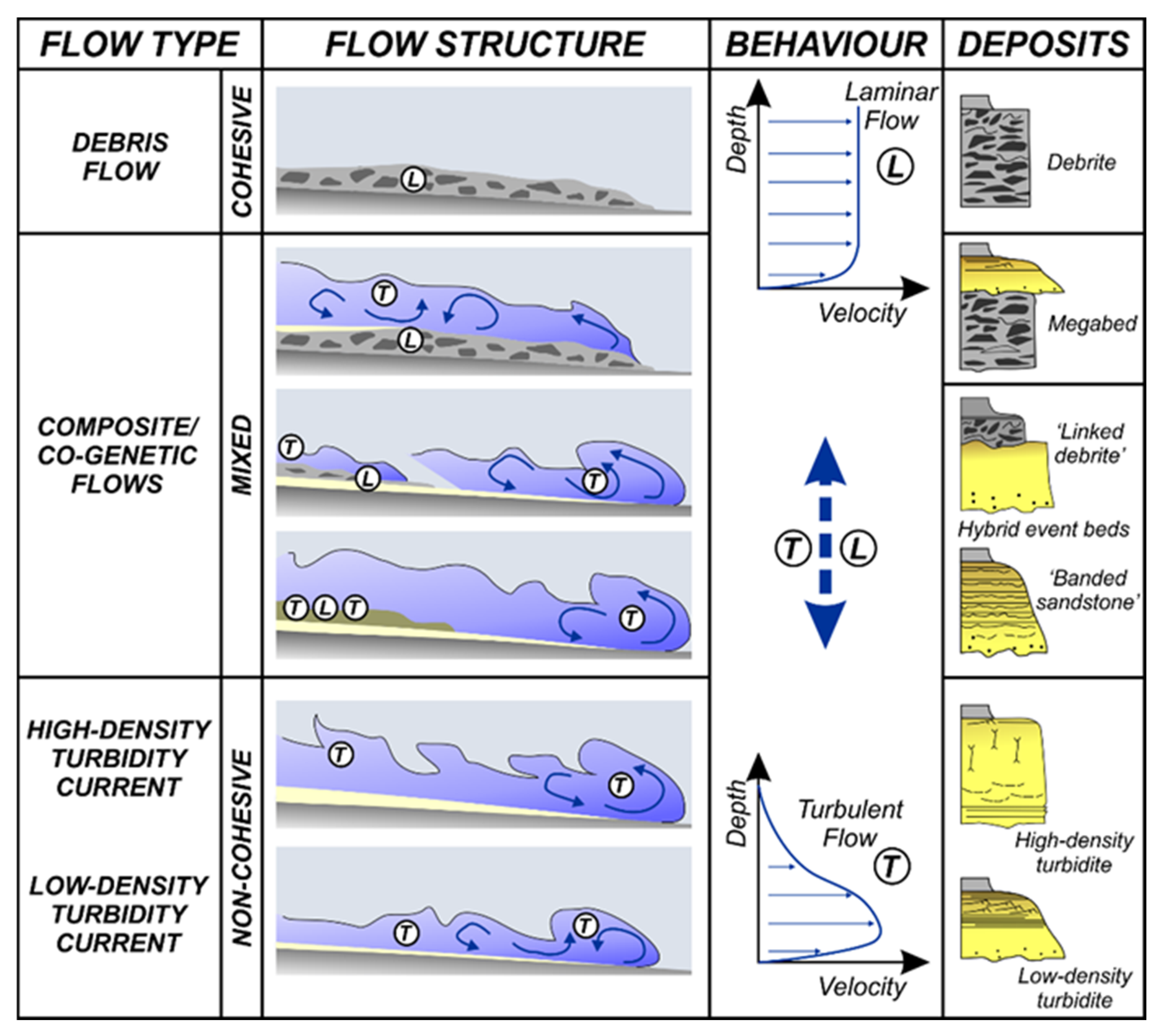
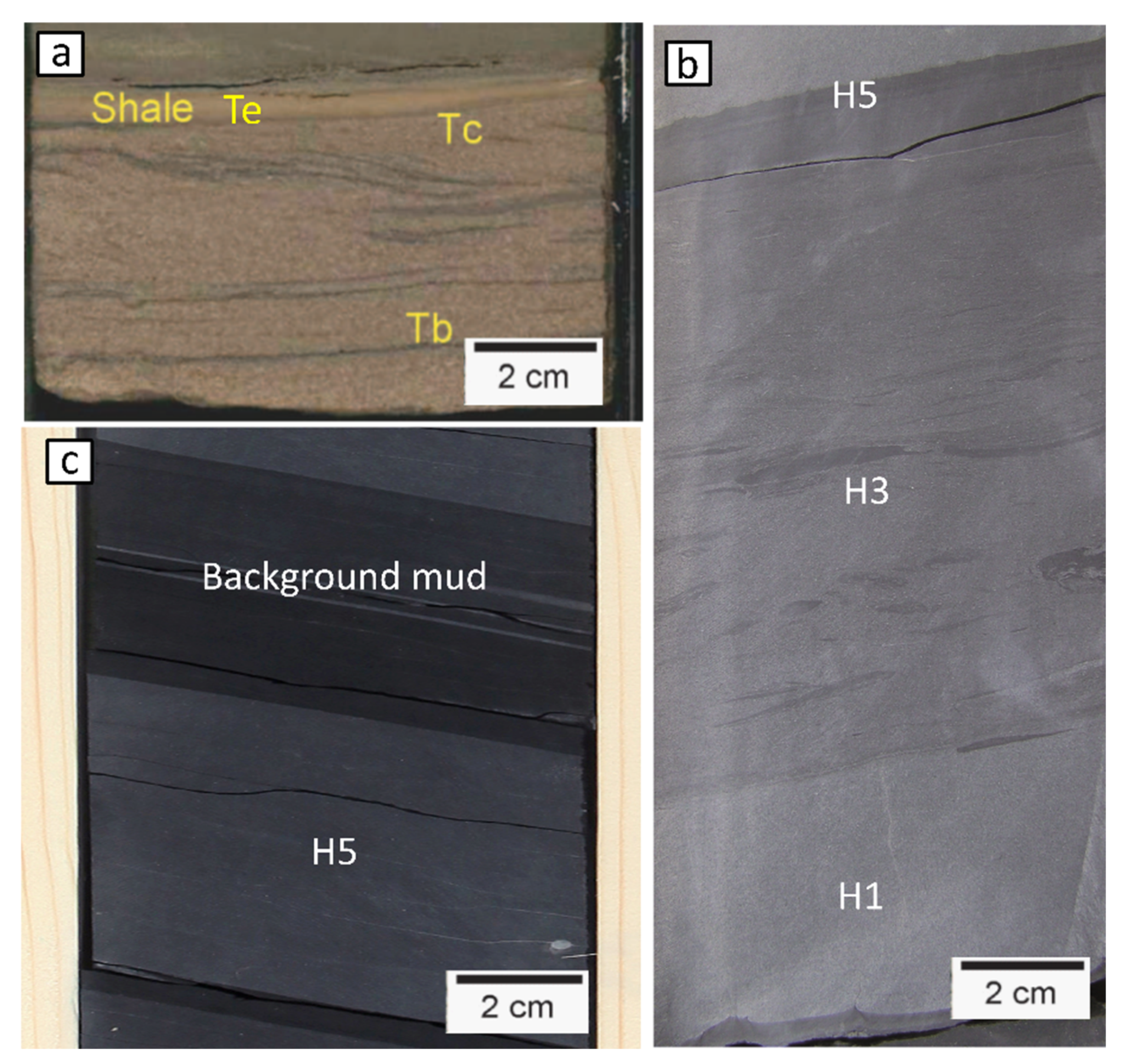
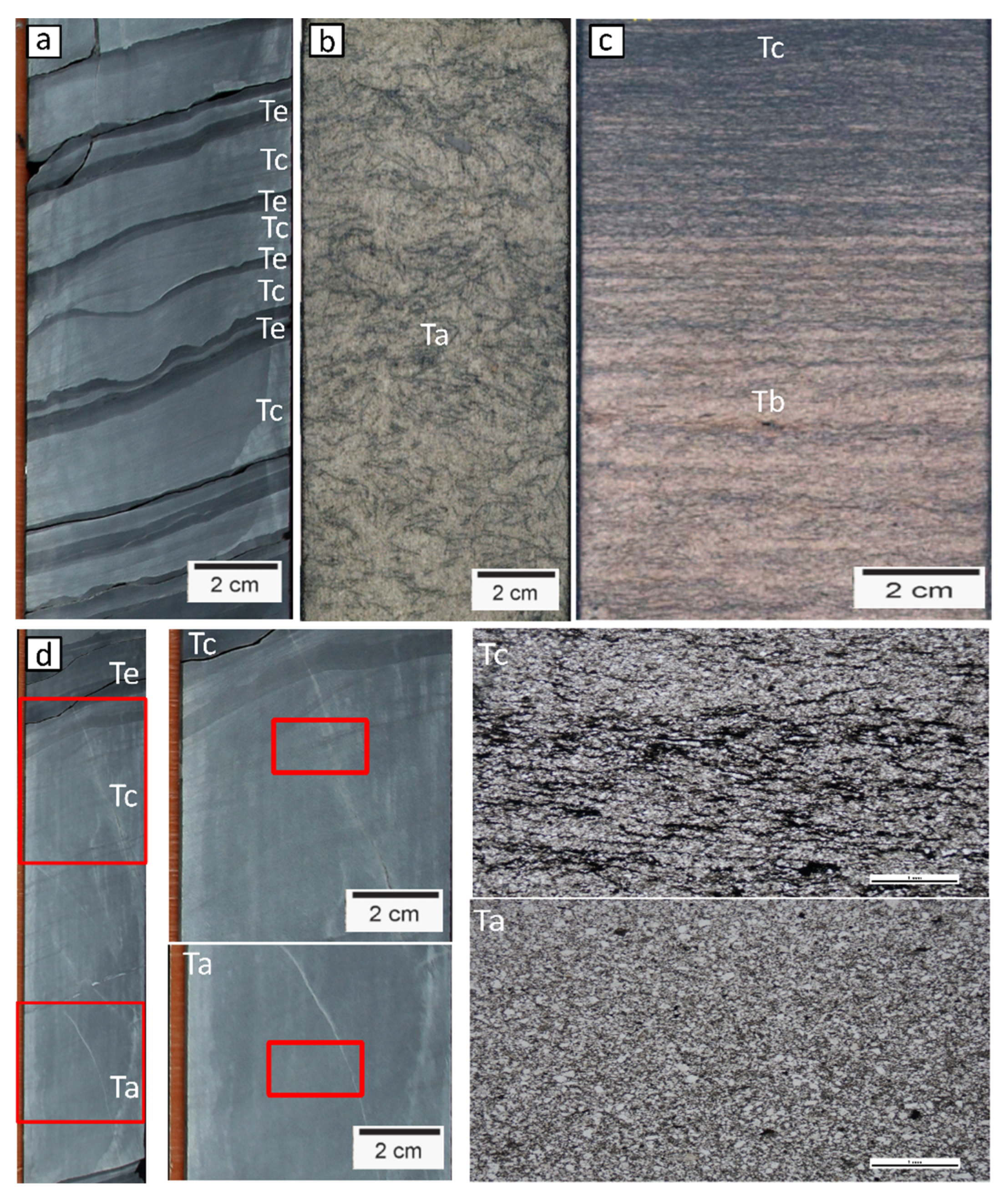
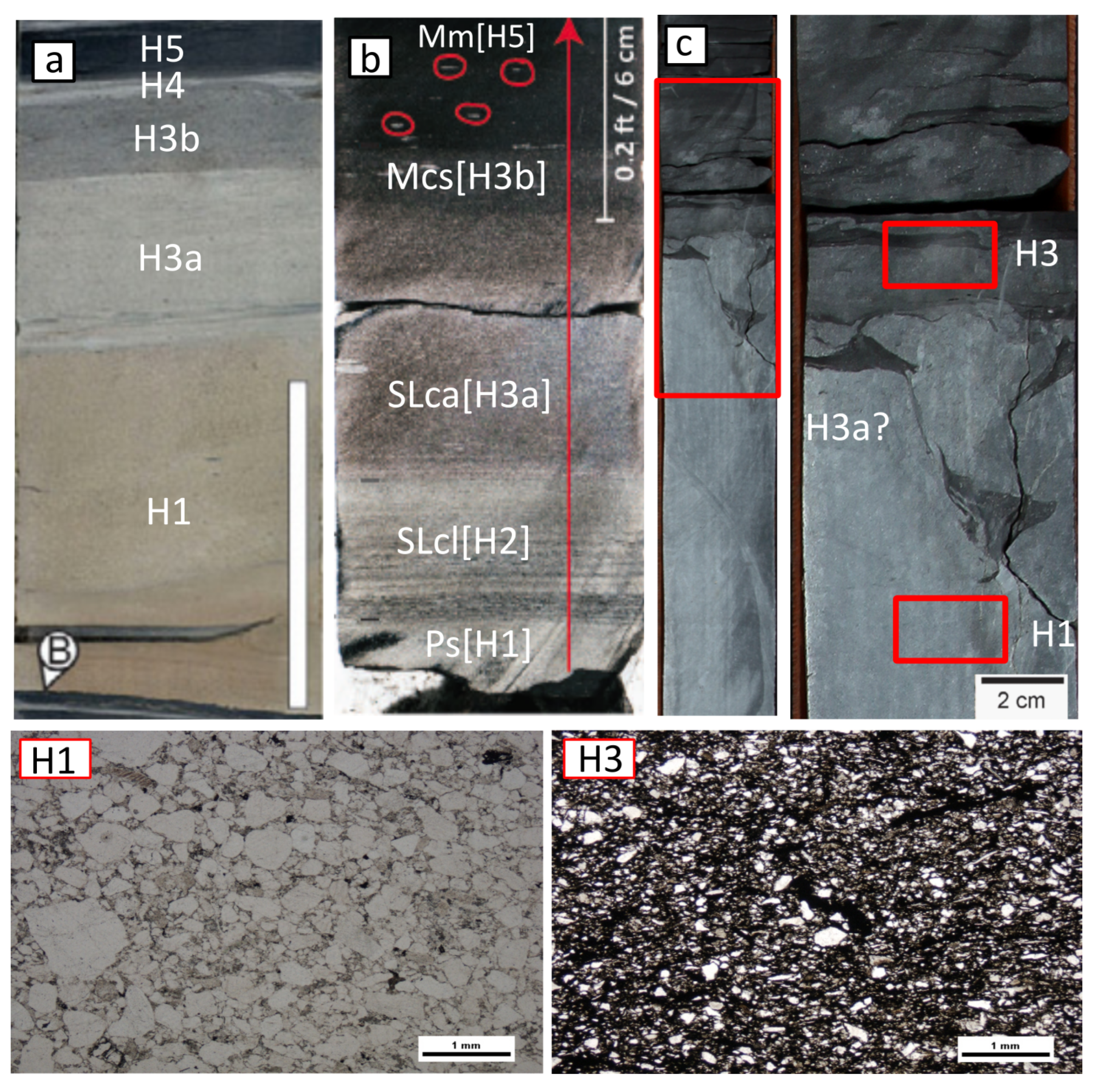
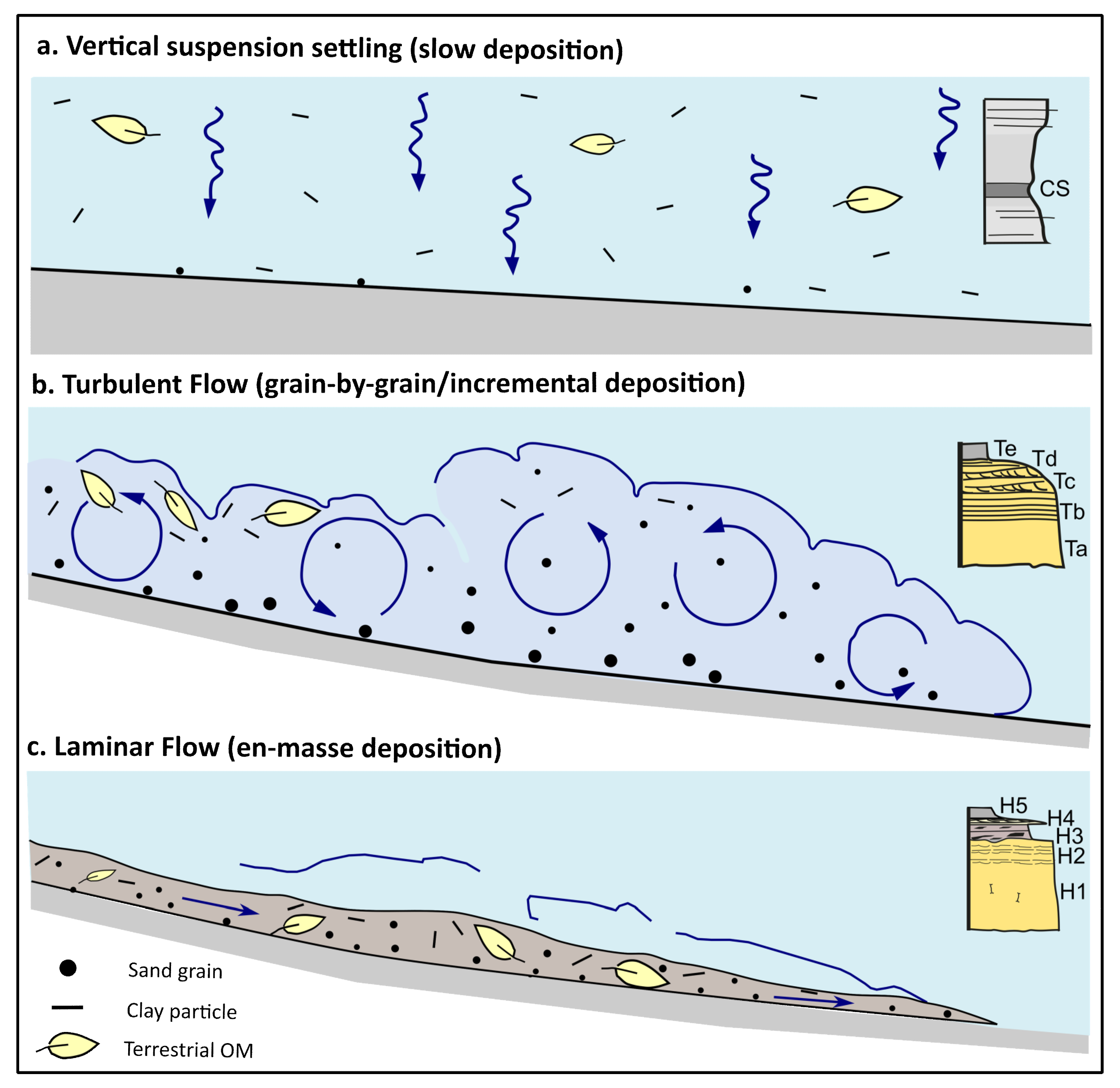
Publisher’s Note: MDPI stays neutral with regard to jurisdictional claims in published maps and institutional affiliations. |
© 2022 by the authors. Licensee MDPI, Basel, Switzerland. This article is an open access article distributed under the terms and conditions of the Creative Commons Attribution (CC BY) license (https://creativecommons.org/licenses/by/4.0/).
Share and Cite
Hussain, A.; Al-Ramadan, K. Organic Matter Burial in Deep-Sea Fans: A Depositional Process-Based Perspective. J. Mar. Sci. Eng. 2022, 10, 682. https://doi.org/10.3390/jmse10050682
Hussain A, Al-Ramadan K. Organic Matter Burial in Deep-Sea Fans: A Depositional Process-Based Perspective. Journal of Marine Science and Engineering. 2022; 10(5):682. https://doi.org/10.3390/jmse10050682
Chicago/Turabian StyleHussain, Arif, and Khalid Al-Ramadan. 2022. "Organic Matter Burial in Deep-Sea Fans: A Depositional Process-Based Perspective" Journal of Marine Science and Engineering 10, no. 5: 682. https://doi.org/10.3390/jmse10050682
APA StyleHussain, A., & Al-Ramadan, K. (2022). Organic Matter Burial in Deep-Sea Fans: A Depositional Process-Based Perspective. Journal of Marine Science and Engineering, 10(5), 682. https://doi.org/10.3390/jmse10050682





